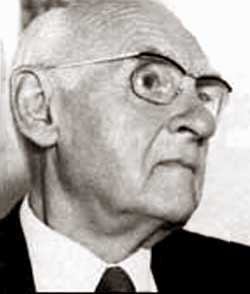 |
Book Reviews
Desire to Offend, Resistance &
the Salvation of Souls
Fr. Paul Sretenovic
Book-review on Animus Injuriandi I, by Atila S. Guimarães,
(Los Angeles: Tradition in Action, 2010), 392 pp.
About Animus Injuriandi I (Desire to Offend I), the last published work of Atila Guimaraes’ Collection on the Council - My God, My God, Why Hast Thou Abandoned Me? - someone presented a question to me. He asked: “Judging by the titles of the volumes - desire to offend and desire to destroy - I would say that there are two camps of progressivists, those who want to destroy the Church and those who “only” wish to offend her. Is this correct?”
No, there are not two parties of progressivists regarding these issues. Practically the same authors are quoted to prove the two intents – to destroy and to offend. They constitute just one powerful current that desires both things. Reading those volumes, we see that many of the periti at the Second Vatican Council, who wrote the documents, and many of the Hierarchs, who applied them to the whole Church, have the same goal of destroying the Church and offending her.
These are not contradictory forces, but perfectly coordinated types of assaults in the same onslaught: a moral attack of offenses, followed by a material attack that aims for the effective destruction of the institution of the Church, her missionary character and her relation with the world as exposed in Volumes IV and V - Animus Delendi I and Animus Delendi II.
In hand-to-hand combat with a formidable enemy, if one is to be victorious, he normally must offend and thereby morally weaken his foe before he can effectively vanquish him. In this case, the ultimate goal is the death of the enemy, but the proximate goal is to cause moral injury.
For example, in Animus Injuriandi I, Fr. Hans Kung offends the authentic sense of Marian apparitions when he accuses of Montanism the little shepherds of Fatima, generically treated as “post-Tridentine visionaries.” Kung criticizes them for “presenting characteristically rigorous moral demands,” referring to the requests of Our Lady to change the immoral customs and to do penance. He also attacks “a higher revelation, a new prophecy ... a special revelation that surpasses what was revealed by Christ,” which alludes to the prediction of the triumph of Our Lady.
Then, he goes on to call the devotees of Fatima “circles of fanatics!” who “find a large audience much more interested in stories and books about the new 'revelations,' 'apparitions' and 'miracles' than in the original Christian message found in the Holy Scripture" (AI, pp. 105-106).
We see in this example that the desire to offend the Marian apparitions walks hand-in-hand with the desire to destroy them. It is obvious that Fr. Kung would like to get rid of all Marian apparitions and devotions to keep people only reading the Bible, like Protestants.
Other parallels could be cited from Progressivists not considered to be as radical in their thinking as Küng, but who nonetheless have spoken in similar fashion.
The Church as a ‘prostitute’

Von Balthasar: the mission of the Church is the mission of a prostitute |
Taken on its own merit, Animus Injuriandi I is divided into two parts, the body of the work and the appendices. In the body, numerous documents in its 11 chapters are transcribed to expose the depraved nature of the attempts to offend the Catholic Church's image and reputation.
One especially shocking example comes in Chapter IV, where one sees progressivists refer to the Church as a "prostitute." Fr. Hans Urs von Balthasar, considered by many conservatives to be orthodox in his writings, stated in his work Casta Meretrix that "the figure of the prostitute ... is so appropriate to the Church that it ... defines the Church of the New Covenant in her most splendid mystery of salvation. ... She must unite and merge herself with all peoples, and this new apostolic form of union cannot be avoided" (p. 139). One can hardly imagine a more offensive statement coming from the mouth of a demon.
There are two appendices at the end of the book. The first examines in more detail the work just cited, Casta Meretrix, further revealing the utter errors, biased arguments and moral perversities in the thinking of Von Balthasar.
A tactical onslaught of offenses
The second appendix is very useful in that it lists the various offenses against the Church as they appear chapter by chapter throughout the book. Just reading through this section can give us more of a sense of the gravity and all-out onslaught that has been raised against Holy Mother Church since the time of the Second Vatican Council.
The progressivists knew that they would not be able to remake the image of the Church into their own likeness overnight, a goal that could be likened to the destruction of Holy Mother Church. They knew that they would have to proceed by stages, weakening the opposition to their schemes through various methods, depending upon which aspect of Church they were trying to change or which obstacle they had to overcome at one point or another.

By promoting Judaism the Conciliar Popes demoralize the doctrine of the Church, always opposed to it |
First, in Animus Delendi I and II (Volumes 4 and 5), Mr. Guimaraes showed us exactly how the progressivists planned to destroy the Church. Now, in this most recent work Animus Injuriandi I (Volume II), he begins to reveal their hatred of the Holy Church. They hate the Church and they plan to destroy her. This denunciation characterizes quite well the setting of the spirit of the Council, normally presented as a manifestation of love for the world and the false religions. On the other side of this alleged love, however, hatred and the deliberate desire to finish with the Catholic Church appear.
Of course, these men cannot destroy the Church. We have Our Lord's promise that the gates of hell will not prevail against her, which stands as a guarantee that she will live forever. Nevertheless, most tragically, while the Church can never be truly destroyed, she is being deformed by the great apostasy we are witnessing now. Conciliar Popes, elevated Hierarchs and celebrated theologians are modifying the Church from head to toe.
To help people to see the full extent of this transformation taking place since the Second Vatican Council, Mr. Guimarães has done a great service for the Church. His work assists a true resistance to this process to be soundly established in order to stop it, so that fewer of her children will be lost to the errors of Progressivism as packaged at the Council.
I cannot recommend enough the latest addition to the series on the Council, Animus Injuriandi I, because by studying the desire to offend Holy Mother Church, one gains a more complete picture of this general apostasy. It also enables us to better answer objections from either the ignorant or the learned, be they enemies or friends.

Posted August 1, 2011

Read more on Animus Injuriandi I

Related Works of Interest
|
|
Book Reviews | Home | Books | CDs | Search | Contact Us | Donate

©2002-
Tradition in Action, Inc. All Rights Reserved
|
 |

|